A Semi-Analytical Optical Remote Sensing Model to Estimate Suspended Sediment and Dissolved Organic Carbon in Tropical Coastal Waters Influenced by Peatland-Draining River Discharges off Sarawak, Borneo
Abstract
:1. Introduction
- (1)
- understand the variability of optical signatures in coastal waters of Sarawak;
- (2)
- develop a remote sensing inversion model coupled with a regional spectral optical library to estimate TSS and DOC using in-situ optical measurements;
- (3)
- demonstrate the application of this inversion model using MODIS Aqua satellite data for Sarawak coastal waters.
2. Materials and Methods
2.1. Study Area
2.2. Field Survey Details
2.3. Biogeophysical Measurements
2.4. Optical Measurements
2.4.1. Inherent Optical Properties (IOP)
2.4.2. Apparent Optical Property Measurements
2.4.3. Relationship between Underwater Remote Sensing Reflectance and Backscattering Albedo
2.5. Statistics
2.6. Remote Sensing Data
3. Modelling Results and Discussion
3.1. Model Structure
3.2. Regional Spectral Optical Library
3.3. Conversion of Underwater Remote Sensing Reflectance and Backscattering Albedo
3.4. Forward Modelling of Backscattering Albedo
3.5. Inversion Model
3.6. Predictive Errors of Inversion Model
3.7. Limitations of the Optical Model
3.8. Model Application to Satellite Remote Sensing Data
4. Conclusions and Future Direction
- Analysis of bio-optical properties showed that specific inherent optical properties of particulate and dissolved substances varied strongly across the coastal region of Sarawak.
- An optical inversion model coupled with the Sarawak spectral optical library successfully retrieved TSS and DOC concentrations from in-situ measurements of backscattering albedo.
- Remote sensing demonstration products of MODIS Aqua-derived TSS and DOC show the influence of river discharges on Sarawak coastal waters.
Author Contributions
Funding
Institutional Review Board Statement
Informed Consent Statement
Data Availability Statement
Acknowledgments
Conflicts of Interest
Appendix A

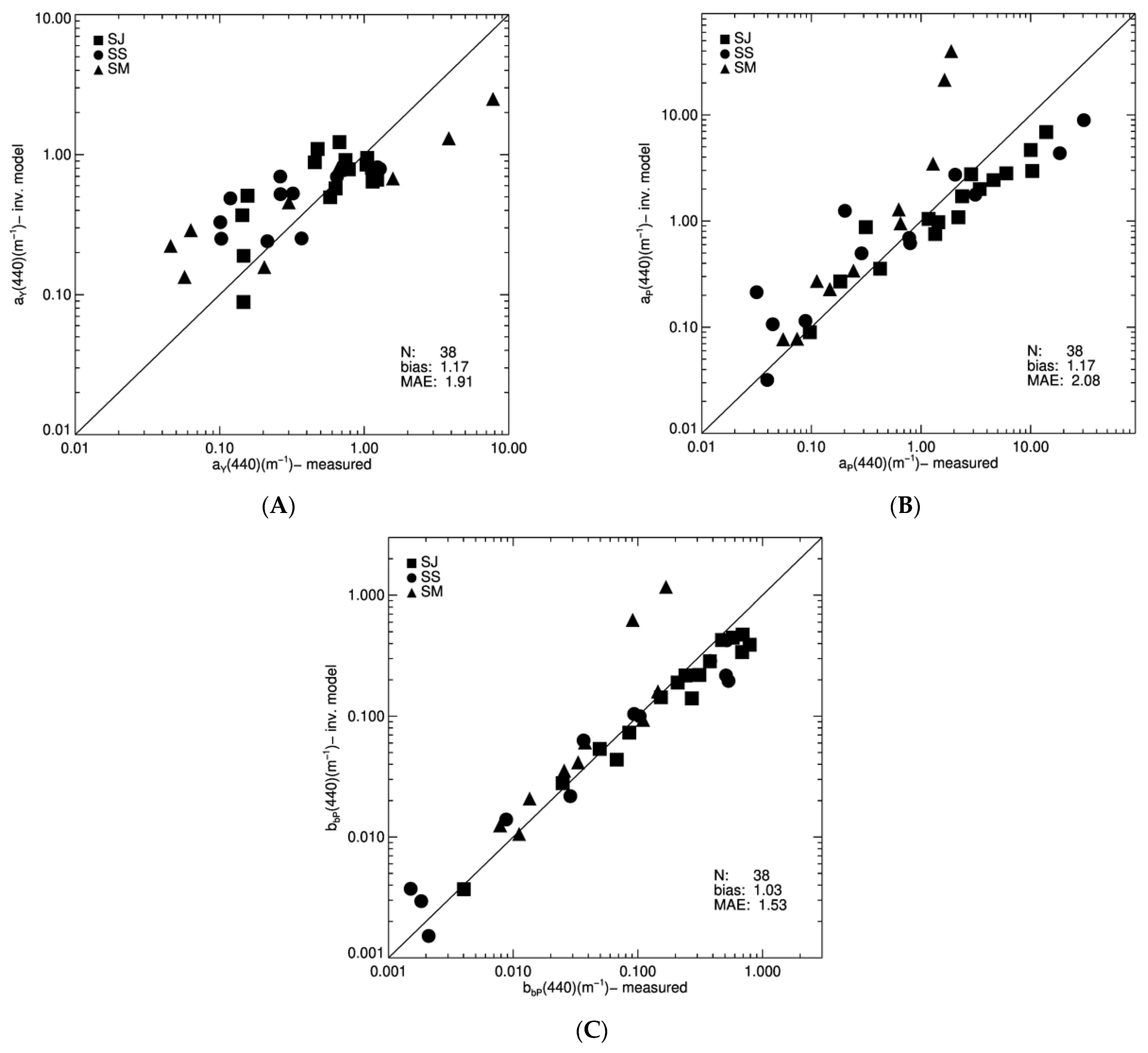
References
- Das, N.; Mahanta, C.; Kumar, M. Water quality under the changing climatic condition: A review of the Indian scenario. In Emerging Issues in the Water Environment during Anthropocene; Springer: Berlin/Heidelberg, Germany, 2020; pp. 31–61. [Google Scholar]
- Fabricius, K.; De’ath, G.; McCook, L.; Turak, E.; Williams, D.M. Changes in algal, coral and fish assemblages along water quality gradients on the inshore Great Barrier Reef. Mar. Pollut. Bull. 2005, 51, 384–398. [Google Scholar] [CrossRef] [PubMed]
- Cao, W.; Wong, M.H. Current status of coastal zone issues and management in China: A review. Environ. Int. 2007, 33, 985–992. [Google Scholar] [CrossRef] [PubMed]
- Cooper, T.F.; Gilmour, J.P.; Fabricius, K.E. Bioindicators of changes in water quality on coral reefs: Review and recommendations for monitoring programmes. Coral Reefs 2009, 28, 589–606. [Google Scholar] [CrossRef] [Green Version]
- Wenger, A.S.; Williamson, D.H.; da Silva, E.T.; Ceccarelli, D.M.; Browne, N.K.; Petus, C.; Devlin, M.J. Effects of reduced water quality on coral reefs in and out of no-take marine reserves. Conserv. Biol. 2016, 30, 142–153. [Google Scholar] [CrossRef] [PubMed]
- Livingston, R.J.; McGlynn, S.E.; Niu, X. Factors controlling seagrass growth in a gulf coastal system: Water and sediment quality and light. Aquat. Bot. 1998, 60, 135–159. [Google Scholar] [CrossRef]
- Saunders, M.I.; Leon, J.; Phinn, S.R.; Callaghan, D.P.; O’Brien, K.R.; Roelfsema, C.M.; Lovelock, C.E.; Lyons, M.B.; Mumby, P.J. Coastal retreat and improved water quality mitigate losses of seagrass from sea level rise. Glob. Chang. Biol. 2013, 19, 2569–2583. [Google Scholar] [CrossRef] [PubMed]
- Lotze, H.K.; Lenihan, H.S.; Bourque, B.J.; Bradbury, R.H.; Cooke, R.G.; Kay, M.C.; Kidwell, S.M.; Kirby, M.X.; Peterson, C.H.; Jackson, J.B.C. Depletion, degradation, and recovery potential of estuaries and coastal seas. Science 2006, 312, 1806–1809. [Google Scholar] [CrossRef] [PubMed]
- Schaffelke, B.; Mellors, J.; Duke, N.C. Water quality in the Great Barrier Reef region: Responses of mangrove, seagrass and macroalgal communities. Mar. Pollut. Bull. 2005, 51, 279–296. [Google Scholar] [CrossRef]
- Cheevaporn, V.; Menasveta, P. Water pollution and habitat degradation in the Gulf of Thailand. Mar. Pollut. Bull. 2003, 47, 43–51. [Google Scholar] [CrossRef]
- Adeyemo, O.K. Consequences of pollution and degradation of Nigerian aquatic environment on fisheries resources. Environmentalist 2003, 23, 297–306. [Google Scholar] [CrossRef]
- Giacomazzo, M.; Bertolo, A.; Brodeur, P.; Massicotte, P.; Goyette, J.-O.; Magnan, P. Linking fisheries to land use: How anthropogenic inputs from the watershed shape fish habitat quality. Sci. Total Environ. 2020, 717, 135377. [Google Scholar] [CrossRef] [PubMed]
- Chong, V.C.; Lee, P.K.Y.; Lau, C.M. Diversity, extinction risk and conservation of Malaysian fishes. J. Fish Biol. 2010, 76, 2009–2066. [Google Scholar] [CrossRef] [PubMed]
- Findlay, S.E.G.; Parr, T.B. Dissolved organic matter. In Methods in Stream Ecology; Elsevier: Amsterdam, The Netherlands, 2017; pp. 21–36. [Google Scholar]
- Bauer, J.E.; Cai, W.-J.; Raymond, P.A.; Bianchi, T.S.; Hopkinson, C.S.; Regnier, P.A.G. The changing carbon cycle of the coastal ocean. Nature 2013, 504, 61–70. [Google Scholar] [CrossRef] [PubMed]
- Newcombe, C.P.; MacDonald, D.D. Effects of suspended sediments on aquatic ecosystems. N. Am. J. Fish. Manag. 1991, 11, 72–82. [Google Scholar] [CrossRef]
- Dodds, W.K.; Whiles, M.R. Quality and quantity of suspended particles in rivers: Continent-scale patterns in the United States. Environ. Manag. 2004, 33, 355. [Google Scholar] [CrossRef]
- Islam, M.S.; Tanaka, M. Impacts of pollution on coastal and marine ecosystems including coastal and marine fisheries and approach for management: A review and synthesis. Mar. Pollut. Bull. 2004, 48, 624–649. [Google Scholar] [CrossRef]
- Wilber, D.H.; Clarke, D.G. Biological Effects of Suspended Sediments: A Review of Suspended Sediment Impacts on Fish and Shellfish with Relation to Dredging Activities in Estuaries. N. Am. J. Fish. Manag. 2001, 21, 855–875. [Google Scholar] [CrossRef]
- Bannister, R.J.; Battershill, C.N.; De Nys, R. Suspended sediment grain size and mineralogy across the continental shelf of the Great Barrier Reef: Impacts on the physiology of a coral reef sponge. Cont. Shelf Res. 2012, 32, 86–95. [Google Scholar] [CrossRef]
- Todd, V.L.G.; Todd, I.B.; Gardiner, J.C.; Morrin, E.C.N.; MacPherson, N.A.; DiMarzio, N.A.; Thomsen, F. A review of impacts of marine dredging activities on marine mammals. ICES J. Mar. Sci. 2015, 72, 328–340. [Google Scholar] [CrossRef] [Green Version]
- Erftemeijer, P.L.A.; Lewis, R.R.R., III. Environmental impacts of dredging on seagrasses: A review. Mar. Pollut. Bull. 2006, 52, 1553–1572. [Google Scholar] [CrossRef]
- Erftemeijer, P.L.A.; Riegl, B.; Hoeksema, B.W.; Todd, P.A. Environmental impacts of dredging and other sediment disturbances on corals: A review. Mar. Pollut. Bull. 2012, 64, 1737–1765. [Google Scholar] [CrossRef] [PubMed]
- Carlson, C.A.; Hansell, D.A. DOM Sources, Sinks, Reactivity, and Budgets. In Biogeochemistry of Marine Dissolved Organic Matter, 2nd ed.; Elsevier: Amsterdam, The Netherlands, 2015; pp. 65–126. [Google Scholar]
- Gattuso, J.-P.; Frankignoulle, M.; Wollast, R. Carbon and carbonate metabolism in coastal aquatic ecosystems. Annu. Rev. Ecol. Syst. 1998, 29, 405–434. [Google Scholar] [CrossRef] [Green Version]
- Barrón, C.; Duarte, C.M. Dissolved organic carbon pools and export from the coastal ocean. Glob. Biogeochem. Cycles 2015, 29, 1725–1738. [Google Scholar] [CrossRef] [Green Version]
- Lønborg, C.; Carreira, C.; Jickells, T.; Álvarez-Salgado, X.A. Impacts of Global Change on Ocean Dissolved Organic Carbon (DOC) Cycling. Front. Mar. Sci. 2020, 7, 466. [Google Scholar] [CrossRef]
- Watanabe, K.; Kuwae, T. How organic carbon derived from multiple sources contributes to carbon sequestration processes in a shallow coastal system? Glob. Chang. Biol. 2015, 21, 2612–2623. [Google Scholar] [CrossRef] [PubMed]
- Ward, N.D.; Bianchi, T.S.; Medeiros, P.M.; Seidel, M.; Richey, J.E.; Keil, R.G.; Sawakuchi, H.O. Where carbon goes when water flows: Carbon cycling across the aquatic continuum. Front. Mar. Sci. 2017, 4, 7. [Google Scholar] [CrossRef] [Green Version]
- Horsburgh, J.S.; Jones, A.S.; Stevens, D.K.; Tarboton, D.G.; Mesner, N.O. A sensor network for high frequency estimation of water quality constituent fluxes using surrogates. Environ. Model. Softw. 2010, 25, 1031–1044. [Google Scholar] [CrossRef]
- Ruhala, S.S.; Zarnetske, J.P. Using in-situ optical sensors to study dissolved organic carbon dynamics of streams and watersheds: A review. Sci. Total Environ. 2017, 575, 713–723. [Google Scholar] [CrossRef]
- Kineke, G.C.; Sternberg, R.W. Measurements of high concentration suspended sediments using the optical backscatterance sensor. Mar. Geol. 1992, 108, 253–258. [Google Scholar] [CrossRef]
- Rai, A.K.; Kumar, A. Continuous measurement of suspended sediment concentration: Technological advancement and future outlook. Measurement 2015, 76, 209–227. [Google Scholar] [CrossRef]
- Earp, A.; Hanson, C.E.; Ralph, P.J.; Brando, V.E.; Allen, S.; Baird, M.; Clementson, L.; Daniel, P.; Dekker, A.G.; Fearns, P.R.C.S. Review of fluorescent standards for calibration of in situ fluorometers: Recommendations applied in coastal and ocean observing programs. Opt. Express 2011, 19, 26768–26782. [Google Scholar] [CrossRef] [PubMed] [Green Version]
- Soja-Woźniak, M.; Baird, M.; Schroeder, T.; Qin, Y.; Clementson, L.; Baker, B.; Boadle, D.; Brando, V.; Steven, A.D.L. Particulate backscattering ratio as an indicator of changing particle composition in coastal waters: Observations from Great Barrier Reef waters. J. Geophys. Res. Oceans 2019, 124, 5485–5502. [Google Scholar]
- Zibordi, G.; Darecki, M. Immersion factors for the RAMSES series of hyper-spectral underwater radiometers. J. Opt. A Pure Appl. Opt. 2006, 8, 252–258. [Google Scholar] [CrossRef]
- Brando, V.E.; Lovell, J.L.; King, E.A.; Boadle, D.; Scott, R.; Schroeder, T. The potential of autonomous ship-borne hyperspectral radiometers for the validation of ocean color radiometry data. Remote Sens. 2016, 8, 150. [Google Scholar] [CrossRef] [Green Version]
- Groom, S.B.; Sathyendranath, S.; Ban, Y.; Bernard, S.; Brewin, B.; Brotas, V.; Brockmann, C.; Chauhan, P.; Choi, J.; Chuprin, A. Satellite ocean colour: Current status and future perspective. Front. Mar. Sci. 2019, 6, 485. [Google Scholar] [CrossRef] [Green Version]
- Gholizadeh, M.H.; Melesse, A.M.; Reddi, L. A comprehensive review on water quality parameters estimation using remote sensing techniques. Sensors 2016, 16, 1298. [Google Scholar] [CrossRef] [Green Version]
- Matthews, M.W. A current review of empirical procedures of remote sensing in inland and near-coastal transitional waters. Int. J. Remote Sens. 2011, 32, 6855–6899. [Google Scholar] [CrossRef]
- Odermatt, D.; Gitelson, A.; Brando, V.E.; Schaepman, M. Review of constituent retrieval in optically deep and complex waters from satellite imagery. Remote Sens. Environ. 2012, 118, 116–126. [Google Scholar] [CrossRef] [Green Version]
- Werdell, P.J.; McKinna, L.I.W.; Boss, E.; Ackleson, S.G.; Craig, S.E.; Gregg, W.W.; Lee, Z.; Maritorena, S.; Roesler, C.S.; Rousseaux, C.S.; et al. An overview of approaches and challenges for retrieving marine inherent optical properties from ocean color remote sensing. Prog. Oceanogr. 2018, 160, 186–212. [Google Scholar] [CrossRef]
- Werdell, P.J.; Franz, B.A.; Bailey, S.W.; Feldman, G.C.; Boss, E.; Brando, V.E.; Dowell, M.; Hirata, T.; Lavender, S.J.; Lee, Z.P.; et al. Generalized ocean color inversion model for retrieving marine inherent optical properties. Appl. Opt. 2013, 52, 2019–2037. [Google Scholar] [CrossRef]
- Garver, S.A.; Siegel, D.A. Inherent optical property inversion of ocean color spectra and its biogeochemical interpretation: 1. Time series from the Sargasso Sea. J. Geophys. Res. Oceans 1997, 102, 18607–18625. [Google Scholar] [CrossRef]
- Lee, Z.; Carder, K.L.; Arnone, R.A. The quasi-analytical algorithm. In Remote Sensing of Inherent Optical Properties: Fundamentals, Tests of Algorithms, and Applications; Chapter 10, IOCCG Report Number 5; International Ocean-Colour Coordinating Group: Dartmouth, NS, Canada, 2006; pp. 73–80. [Google Scholar]
- Long, S.M. Sarawak Coastal Biodiversity: A Current Status. Kuroshio Sci. 2014, 8, 71–84. [Google Scholar]
- White, A.T.; Aliño, P.M.; Cros, A.; Fatan, N.A.; Green, A.L.; Teoh, S.J.; Laroya, L.; Peterson, N.; Tan, S.; Tighe, S. Marine protected areas in the Coral Triangle: Progress, issues, and options. Coast. Manag. 2014, 42, 87–106. [Google Scholar] [CrossRef]
- Miettinen, J.; Shi, C.; Liew, S.C. Land cover distribution in the peatlands of Peninsular Malaysia, Sumatra and Borneo in 2015 with changes since 1990. Glob. Ecol. Conserv. 2016, 6, 67–78. [Google Scholar] [CrossRef] [Green Version]
- Miettinen, J.; Liew, S.C. Degradation and development of peatlands in Peninsular Malaysia and in the islands of Sumatra and Borneo since 1990. Land Degrad. Dev. 2010, 21, 285–296. [Google Scholar] [CrossRef]
- Ling, T.-Y.; Jaafar, N.; Nyanti, L. Water and sediment quality near shrimp aquaculture farm in Selang Sibu River, Telaga Air, Sarawak, Malaysia. World Appl. Sci. J. 2012, 18, 855–860. [Google Scholar]
- Soo, C.-L.; Ling, T.-Y.; Lee, N. Assessment of the water quality of the western boundary of Kuching Wetland National Park, Sarawak, Malaysia. Borneo J. Resour. Sci. Technol. 2015, 5, 1–10. [Google Scholar] [CrossRef] [Green Version]
- ChunHock, S.; Cherukuru, N.; Mujahid, A.; Martin, P.; Sanwlani, N.; Warneke, T.; Rixen, T.; Notholt, J.; Müller, M. A New Remote Sensing Method to Estimate River to Ocean DOC Flux in Peatland Dominated Sarawak Coastal Regions, Borneo. Remote Sens. 2020, 12, 3380. [Google Scholar] [CrossRef]
- Sa’adi, Z.; Shahid, S.; Chung, E.-S.; bin Ismail, T. Projection of spatial and temporal changes of rainfall in Sarawak of Borneo Island using statistical downscaling of CMIP5 models. Atmos. Res. 2017, 197, 446–460. [Google Scholar] [CrossRef]
- Ling, T.Y.; Soo, C.L.; Sivalingam, J.R.; Nyanti, L.; Sim, S.F.; Grinang, J. Assessment of the Water and Sediment Quality of Tropical Forest Streams in Upper Reaches of the Baleh River, Sarawak, Malaysia, Subjected to Logging Activities. J. Chem. 2016, 2016. [Google Scholar] [CrossRef]
- Pilcher, N.; Cabanban, S.A. The Status of Coral Reefs in Eastern Malaysia Global Coral Reef Monitoring Network (GCRMN) Report; Australia Institute of Marine Science: Townsville, Australia, 2000; pp. 1–81. [Google Scholar]
- Sun, C. Riverine influence on ocean color in the equatorial South China Sea. Cont. Shelf Res. 2017, 143, 151–158. [Google Scholar] [CrossRef]
- Tilstone, G.H.; Moore, G.F.; Sørensen, K.; Doerffer, R.; Røttgers, R.; Ruddick, K.G.; Pasterkamp, R.; Jørgensen, P.V. Protocols for the validation of MERIS products in Case 2 waters. In Proceedings of the ENVISAT MAVT Conference, Frascatti, Italy, 20–24 October 2003; pp. 20–24. [Google Scholar]
- Martin, P.; Cherukuru, N.; Tan, A.S.Y.; Sanwlani, N.; Mujahid, A.; Müller, M. Distribution and cycling of terrigenous dissolved organic carbon in peatland-draining rivers and coastal waters of Sarawak, Borneo. Biogeosciences 2018, 15, 6847–6865. [Google Scholar] [CrossRef] [Green Version]
- Cherukuru, N.; Dekker, A.G.; Hardman-Mountford, N.J.; Clementson, L.A.; Thompson, P.A. Bio-optical variability in multiple water masses across a tropical shelf: Implications for ocean colour remote sensing models. Estuar. Coast. Shelf Sci. 2019, 219, 223–230. [Google Scholar] [CrossRef]
- Oubelkheir, K.; Ford, P.W.; Clementson, L.A.; Cherukuru, N.; Fry, G.; Steven, A.D.L. Impact of an extreme flood event on optical and biogeochemical properties in a subtropical coastal periurban embayment (Eastern Australia). J. Geophys. Res. Oceans 2014, 119, 6024–6045. [Google Scholar] [CrossRef]
- Retelletti Brogi, S.; Derrien, M.; Hur, J. In-Depth Assessment of the Effect of Sodium Azide on the Optical Properties of Dissolved Organic Matter. J. Fluoresc. 2019, 29, 877–885. [Google Scholar] [CrossRef]
- Mitchell, B.G. Algorithms for determining the absorption coefficient for aquatic particulates using the quantitative filter technique. In Proceedings of the Ocean Optics X; Spinrad, R.W., Ed.; SPIE: Bellingham, WA, USA, 1990; Volume 1302, p. 137. [Google Scholar]
- Green, S.A.; Blough, N.V. Optical absorption and fluorescence properties of chromophoric dissolved organic matter in natural waters. Limnol. Oceanogr. 1994, 39, 1903–1916. [Google Scholar] [CrossRef]
- Babin, M. Variations in the light absorption coefficients of phytoplankton, nonalgal particles, and dissolved organic matter in coastal waters around Europe. J. Geophys. Res. Oceans 2003, 108, 3211. [Google Scholar] [CrossRef]
- Morel, A. Optical properties of pure water and pure sea water. In Optical Aspects of Oceanography; Jerlov, N.G., Nielsen, E.S., Eds.; Academic Press: New York, NY, USA, 1974; pp. 1–24. [Google Scholar]
- Boss, E.; Pegau, W.S. Relationship of light scattering at an angle in the backward direction to the backscattering coefficient. Appl. Opt. 2001, 40, 5503–5507. [Google Scholar] [CrossRef]
- Lee, Z.; Carder, K.L.; Arnone, R.A. Deriving inherent optical properties from water color: A multiband quasi-analytical algorithm for optically deep waters. Appl. Opt. 2002, 41, 5755–5772. [Google Scholar] [CrossRef]
- Oubelkheir, K.; Clementson, L.A.; Webster, I.T.; Ford, P.W.; Dekker, A.G.; Radke, L.C.; Daniel, P. Using inherent optical properties to investigate biogeochemical dynamics in a tropical macrotidal coastal system. J. Geophys. Res. Oceans 2006, 111, 1–15. [Google Scholar] [CrossRef] [Green Version]
- Lee, Z.-P. A model for the diffuse attenuation coefficient of downwelling irradiance. J. Geophys. Res. Oceans 2005, 110, C02016. [Google Scholar] [CrossRef]
- Gould, R.W., Jr.; Arnone, R.A.; Sydor, M. Absorption, scattering, and, remote-sensing reflectance relationships in coastal waters: Testing a new inversion algorith. J. Coast. Res. 2001, 17, 328–341. [Google Scholar]
- Aurin, D.A.; Dierssen, H.M. Advantages and limitations of ocean color remote sensing in CDOM-dominated, mineral-rich coastal and estuarine waters. Remote Sens. Environ. 2012, 125, 181–197. [Google Scholar] [CrossRef]
- Mueller, J.L.; Fargion, G.S. Ocean Optics Protocols for Satellite Ocean Color Sensor Validation, Revision 3; National Aeronautics and Space Administration, Goddard Space Flight Center: Greenbelt, MD, USA, 2002; Volume 210004. [Google Scholar]
- Lee, Z.; Carder, K.L.; Mobley, C.D.; Steward, R.G.; Patch, J.S. Hyperspectral remote sensing for shallow waters. I. A semianalytical model. Appl. Opt. 1998, 37, 6329–6338. [Google Scholar] [CrossRef]
- Hirata, T.; Højerslev, N.K. Relationship between the irradiance reflectance and inherent optical properties of seawater. J. Geophys. Res. Oceans 2008, 113. [Google Scholar] [CrossRef] [Green Version]
- Zibordi, G.; Berthon, J.F. Relationships between Q-factor and seawater optical properties in a coastal region. Limnol. Oceanogr. 2001, 46, 1130–1140. [Google Scholar] [CrossRef]
- Seegers, B.N.; Stumpf, R.P.; Schaeffer, B.A.; Loftin, K.A.; Werdell, P.J. Performance metrics for the assessment of satellite data products: An ocean color case study. Opt. Express 2018, 26, 7404–7422. [Google Scholar] [CrossRef] [Green Version]
- Bailey, S.W.; Franz, B.A.; Werdell, P.J. Estimation of near-infrared water-leaving reflectance for satellite ocean color data processing. Opt. Express 2010, 18, 7521–7527. [Google Scholar] [CrossRef]
- Goyens, C.; Jamet, C.; Schroeder, T. Evaluation of four atmospheric correction algorithms for MODIS-Aqua images over contrasted coastal waters. Remote Sens. Environ. 2013, 131, 63–75. [Google Scholar] [CrossRef]
- Ambarwulan, W.; Salama, M.S.; Mannaerts, C.M.; Verhoef, W. Estimating specific inherent optical properties of tropical coastal waters using bio-optical model inversion and in situ measurements: Case of the Berau estuary, East Kalimantan, Indonesia. Hydrobiologia 2011, 658, 197–211. [Google Scholar] [CrossRef] [Green Version]
- Bowers, D.G.; Md-Suffian, I.; Mitchelson-Jacob, E.G. Bio-optical properties of east coast Malaysia waters in relation to remote sensing of chlorophyll. Int. J. Remote Sens. 2012, 33, 150–169. [Google Scholar] [CrossRef]
- Doxaran, D.; Cherukuru, N.; Lavender, S.J. Apparent and inherent optical properties of turbid estuarine waters: Measurements, empirical quantification relationships, and modeling. Appl. Opt. 2006, 45, 2310–2324. [Google Scholar] [CrossRef] [PubMed]
- Budhiman, S.; Suhyb Salama, M.; Vekerdy, Z.; Verhoef, W. Deriving optical properties of Mahakam Delta coastal waters, Indonesia using in situ measurements and ocean color model inversion. ISPRS J. Photogramm. Remote Sens. 2012, 68, 157–169. [Google Scholar] [CrossRef]
- Kirk, J.T.O. Light and Photosynthesis in Aquatic Ecosystems, 3rd ed.; Cambridge University Press: Cambridge, UK, 2010. [Google Scholar]
- Zhou, Y.; Martin, P.; Müller, M. Composition and cycling of dissolved organic matter from tropical peatlands of coastal Sarawak, Borneo, revealed by fluorescence spectroscopy and parallel factor analysis. Biogeosciences 2019, 16, 2733–2749. [Google Scholar] [CrossRef] [Green Version]
- Ambarwulan, W.; Budhiman, S. Deriving Inherent Optical Properties from MERIS imagery and in situ measurement using quasi-analytical-algorithm. Int. J. Remote Sens. Earth Sci. 2013, 1, 454–460. [Google Scholar] [CrossRef] [Green Version]
- Slade, W.H.; Boss, E. Spectral attenuation and backscattering as indicators of average particle size. Appl. Sci. 2015, 54, 7264–7277. [Google Scholar] [CrossRef]
- Stramski, D.; Boss, E.; Bogucki, D.; Voss, K.J. The role of seawater constituents in light backscattering in the ocean. Prog. Oceanogr. 2004, 61, 27–56. [Google Scholar] [CrossRef]
- Gordon, H.R.; Brown, O.B.; Evans, R.H.; Brown, J.W.; Smith, R.C.; Baker, K.S.; Clark, D.K. A semianalytic radiance model of ocean color. J. Geophys. Res. Atmos. 1988, 93, 10909–10924. [Google Scholar] [CrossRef]
- Brando, V.E.; Dekker, A.G.; Park, Y.J.; Schroeder, T. Adaptive semianalytical inversion of ocean color radiometry in optically complex waters. Appl. Opt. 2012, 51, 2808–2833. [Google Scholar] [CrossRef]
- Liew, S.-C.; Chia, A.S.; Lim, K.H.; Kwoh, L.K. Modeling the reflectance spectra of tropical coastal waters. In Proceedings of the Ocean Optics: Remote Sensing and Underwater Imaging; International Society for Optics and Photonics: Bellingham, WA, USA, 2002; Volume 4488, pp. 248–255. [Google Scholar]
- Froidefond, J.-M.; Gardel, L.; Guiral, D.; Parra, M.; Ternon, J.-F. Spectral remote sensing reflectances of coastal waters in French Guiana under the Amazon influence. Remote Sens. Environ. 2002, 80, 225–232. [Google Scholar] [CrossRef]
- Cherukuru, N.; Brando, V.E.; Schroeder, T.; Clementson, L.A.; Dekker, A.G. Influence of river discharge and ocean currents on coastal optical properties. Cont. Shelf Res. 2014, 84, 188–203. [Google Scholar] [CrossRef]
- Marquardt, D.W. An algorithm for least-squares estimation of nonlinear parameters. J. Soc. Ind. Appl. Math. 1963, 11, 431–441. [Google Scholar] [CrossRef]
- Press, W.H.; Teukolsky, S.A.; Vetterling, W.T.; Flannery, B.P. Numerical Recipies in C. Error, Accuracy, and Stability; Cambridge University Press: Cambridge, UK, 1992. [Google Scholar]
- Markwardt, C.B. Non-linear least squares fitting in IDL with MPFIT. arXiv 2009, arXiv:0902.2850. [Google Scholar]
- Roesler, C.S. Spectral beam attenuation coefficient retrieved from ocean color inversion. Geophys. Res. Lett. 2003, 30, 1–4. [Google Scholar] [CrossRef] [Green Version]
- Zhang, M.; Tang, J.; Dong, Q.; Song, Q.; Ding, J. Retrieval of total suspended matter concentration in the Yellow and East China Seas from MODIS imagery. Remote Sens. Environ. 2010, 114, 392–403. [Google Scholar] [CrossRef]
- Maritorena, S.; Siegel, D.A.; Peterson, A.R. Optimization of a semianalytical ocean color model for global-scale applications. Appl. Opt. 2002, 41, 2705–2714. [Google Scholar] [CrossRef]
- Welham, S.J.; Gezan, S.A.; Clark, S.J.; Mead, A. Statistical Methods in Biology: Design and Analysis of Experiments and Regression; CRC Press: Boca Raton, FL, USA, 2014; ISBN 1439898057. [Google Scholar]



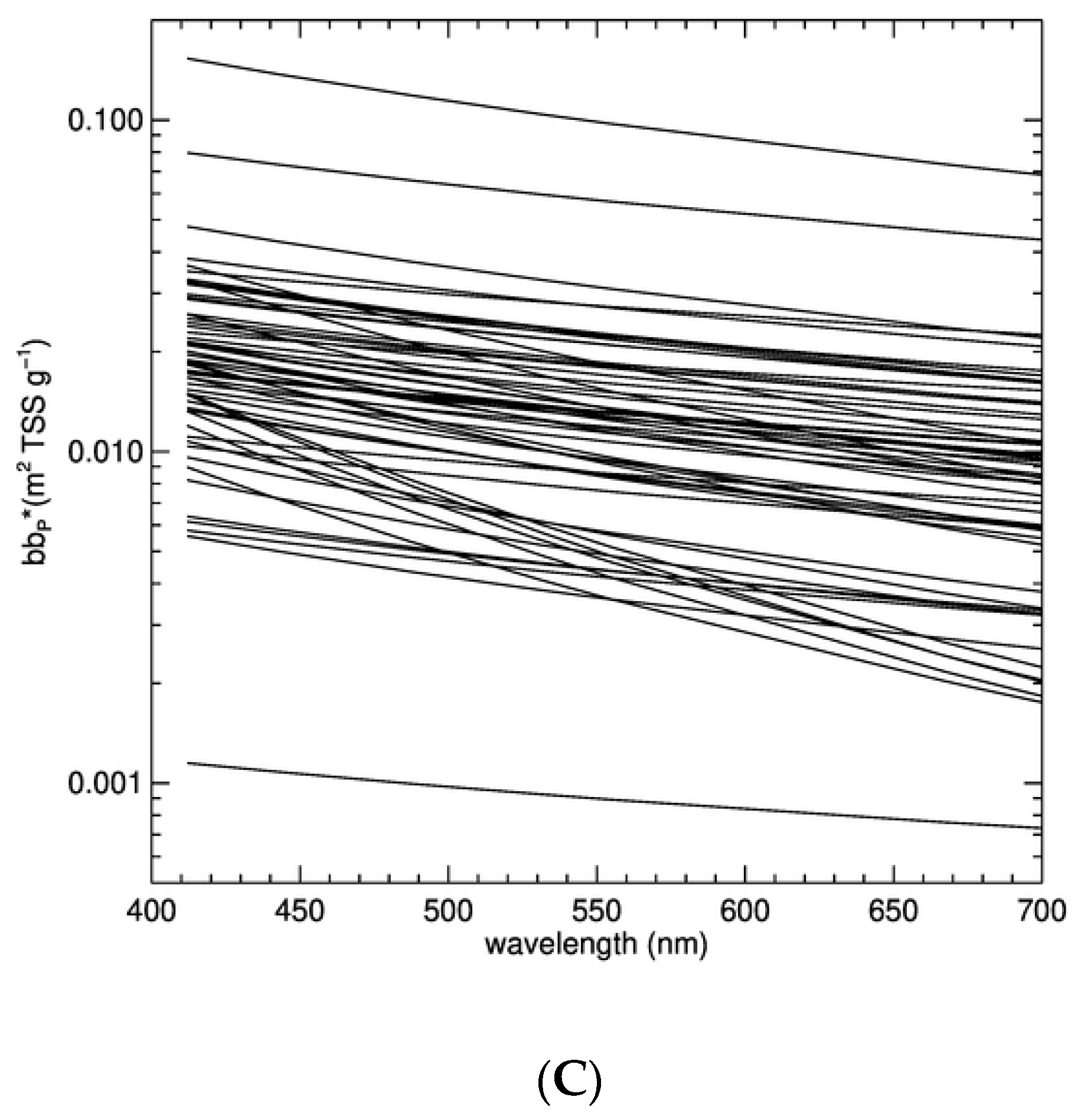

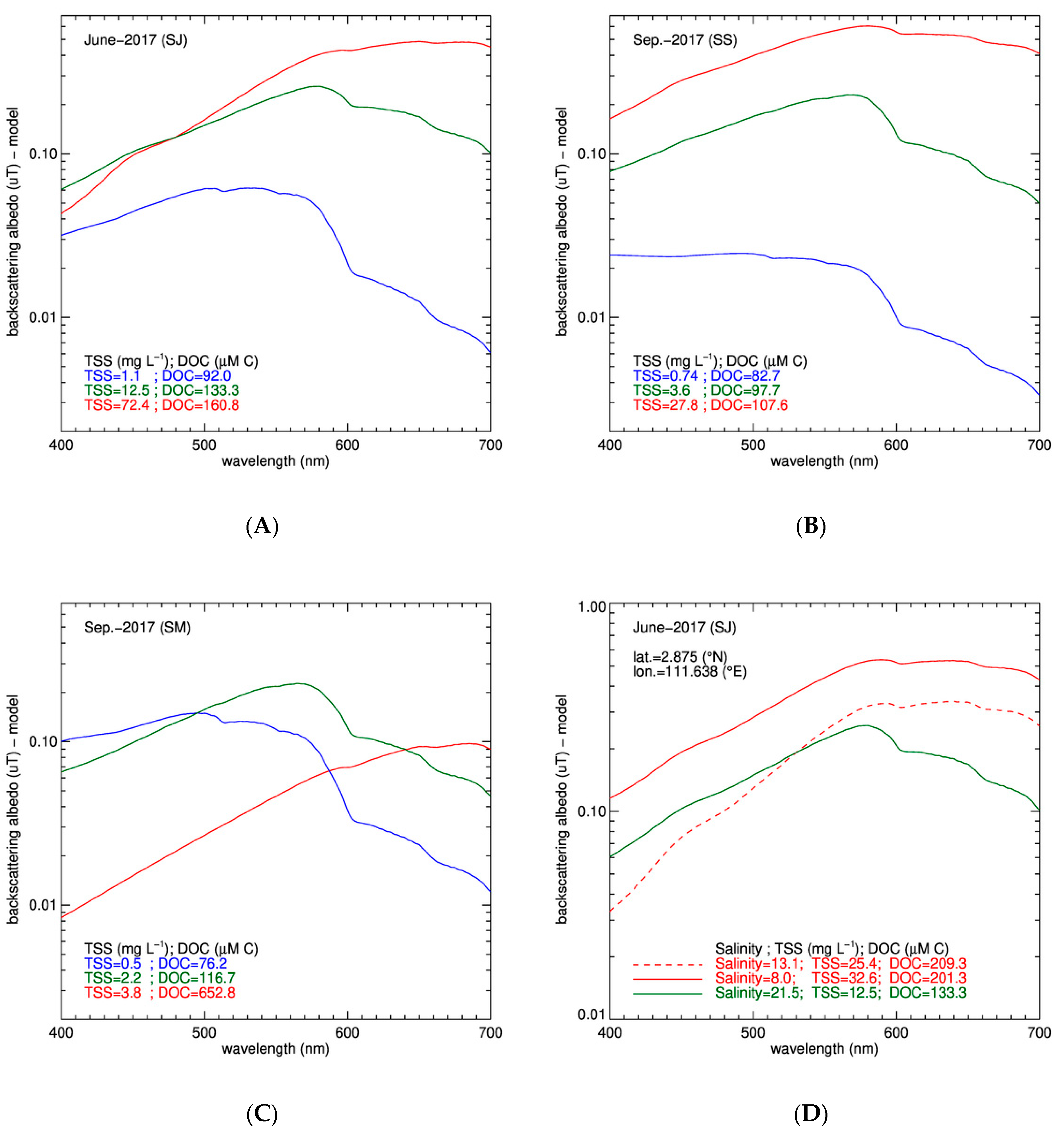

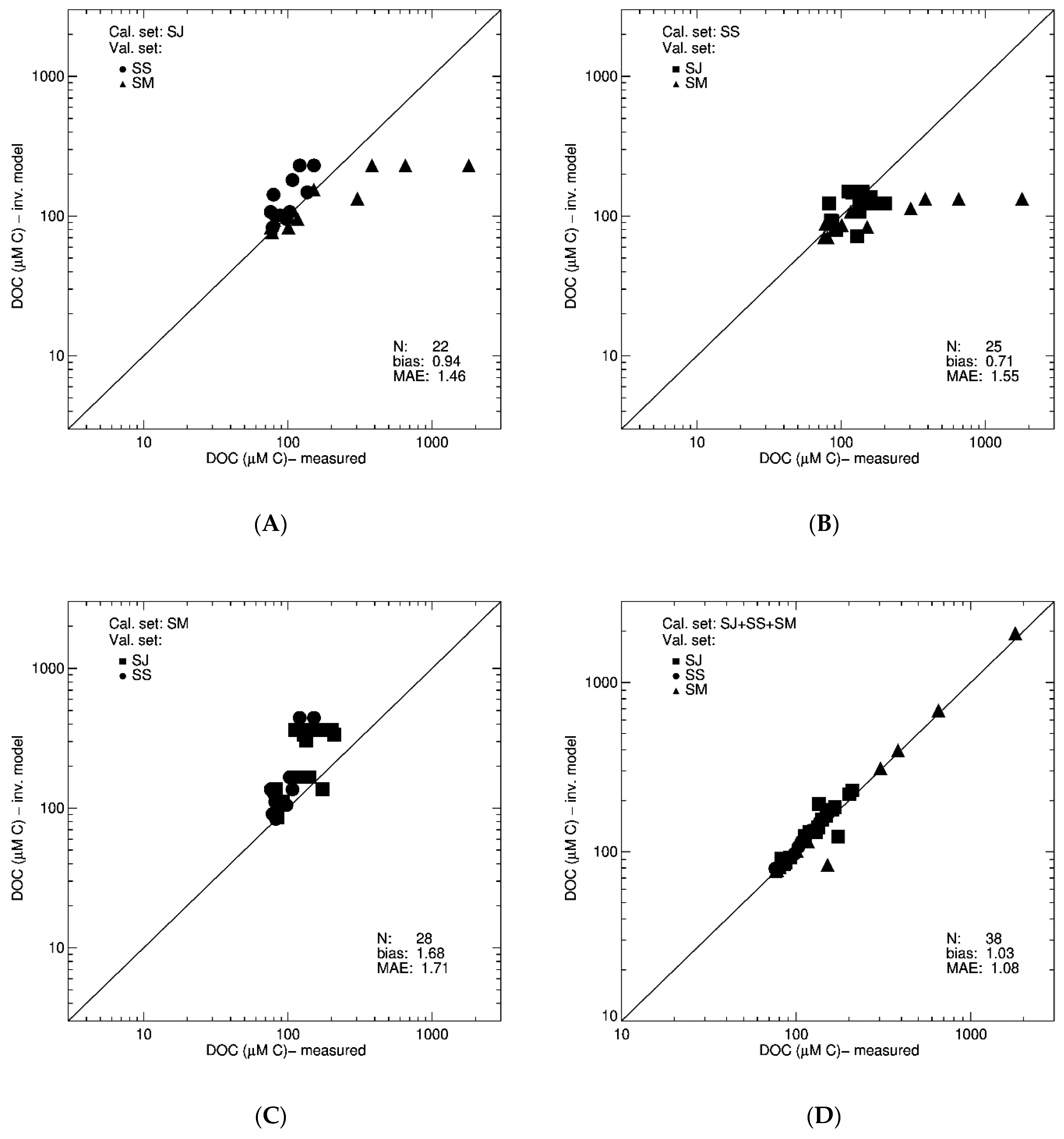



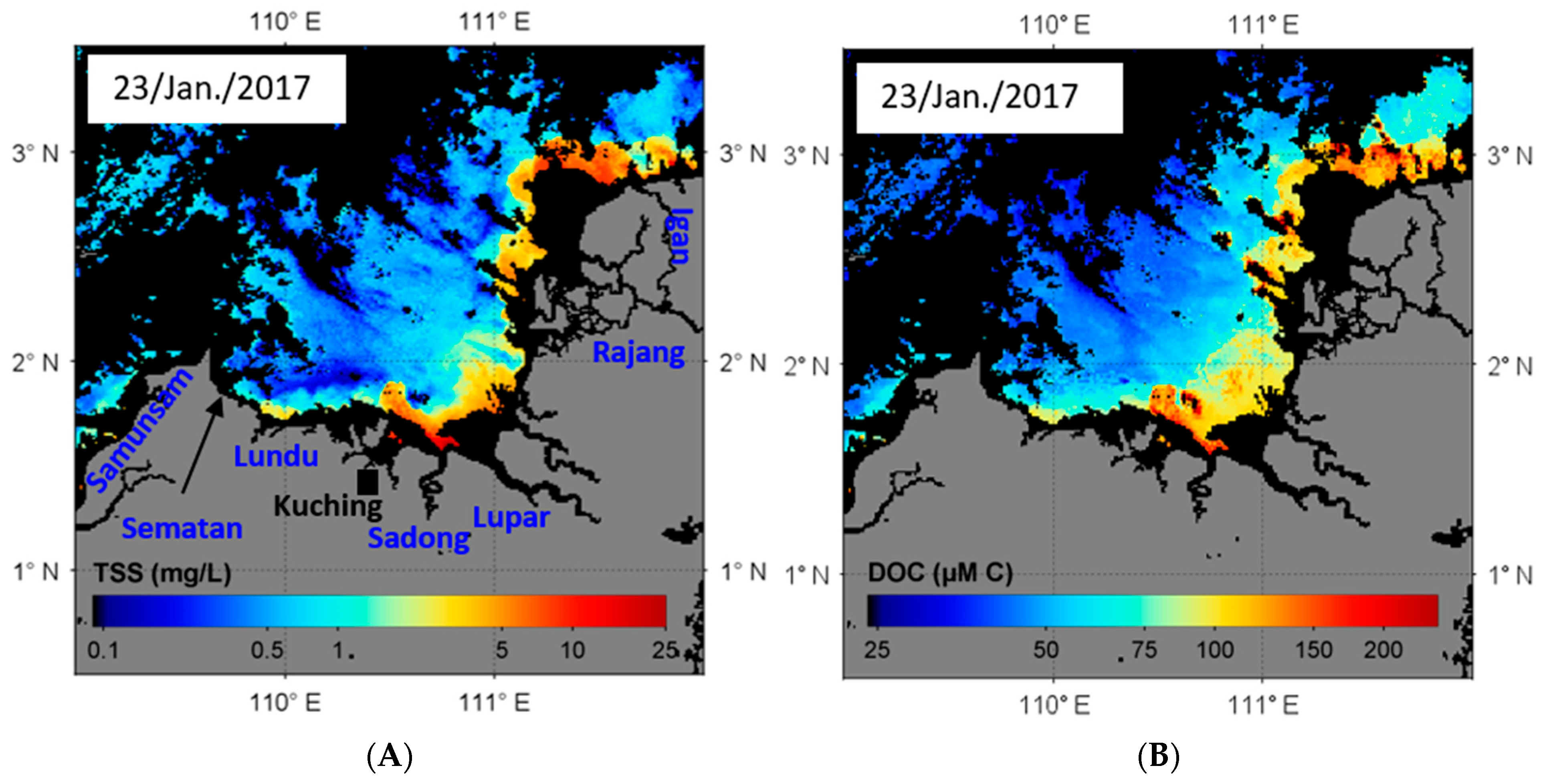

| SJ2017 | SS2017 | SM2017 | ||||
|---|---|---|---|---|---|---|
| Parameter [Units] | [N] Min.–Max. | Mean (CV%) | [N] Min.–Max. | Mean (CV%) | [N] Min.–Max. | Mean (CV%) |
| Temperature [°C] | [23] 28.8–31.6 | 30.0 (2.2) | [25] 26.6–30.9 | 28.8 (4.1) | [20] 28.6–31.5 | 30.33 (2.3) |
| Salinity | [23] 4.7–32.2 | 25.5 (31.8) | [19] 18.6–31.9 | 28.5 (13.9) | [20] 2.0–32.5 | 28.0 (28.2) |
| TSS, [mg L−1] | [24] 1.1–174.6 | 29.8 (134.8) | [21] 0.56–174.5 | 23.9 (164.8) | [20] 0.5–10.5 | 3.8 (86.5) |
| DOC, [µMC] | [25] 80.9–209.3 | 120.7 (31.4) | [22] 76.0–166.3 | 106.7 (26.8) | [21] 76.2–1798.7 | 330.0 (142.4) |
| aY(440) [m−1] | [25] 0.2219–2.834 | 1.1362 (77.7) | [24] 0.1009–1.858 | 0.627 (79.2) | [20] 0.0457–23.97 | 3.6102 (194.5) |
| aY*(440) [m−1 µMC−1] | [25] 0.0027–0.0203 | 0.0083 (57.7) | [19] 0.0013–0.0162 | 0.0047 (76.5) | [20] 0.0006–0.0148 | 0.0045 (112.6) |
| SY(x–1.) [nm−1] | [25] 0.0088–0.0182 | 0.0161 (11.4) | [24] 0.0047–0.021 | 0.0138 (29.5) | [20] 0.0138–0.0181 | 0.0159 (7.9) |
| bbP(650) [m−1] | [21] 0.0016–0.7057 | 0.2416 (103.3) | [23] 0.0015–2.48 | 0.2896 (191.3) | [15] 0.0112–0.168 | 0.0462 (94.0) |
| bbP*(650) [m2 TSS g−1] | [20] 0.0036–0.0246 | 0.0097 (50.9) | [19] 0.0008–0.0765 | 0.0014 (125.9) | [14] 0.0034–0.0239 | 0.0147 (41.39) |
| Sbbp(x–1.) [nm−1] | [21] 0.93–2.39 | 1.69 (28.7) | [23] 0.40–3.75 | 1.3 (55.1) | [15] 0.76–1.33 | 1.1 (13.6) |
| aP*(412) [m2 TSS g−1] | [16] 0.0567–0.4469 | 0.1684 (59.6) | [16] 0.0157–0.1596 | 0.1034 (45.5) | [11] 0.1029–0.6294 | 0.2301 (77.9) |
| aP*(443) [m2 TSS g−1] | [16] 0.0451–0.2213 | 0.1008 (48.8) | [16] 0.0157–0.121 | 0.0718 (39.25) | [11] 0.0708–0.4144 | 0.1607 (71.25) |
| aP*(488) [m2 TSS g−1] | [16] 0.0268–0.1138 | 0.0585 (44.9) | [16] 0.0091–0.0769 | 0.0441 (42.9) | [11] 0.04418–0.2529 | 0.0979 (73.7) |
| aP*(531) [m2 TSS g−1] | [16] 0.0136–0.0516 | 0.0284 (40.7) | [16] 0.0037–0.0337 | 0.0206 (41.4) | [11] 0.0230–0.1614 | 0.0556 (90.4) |
| aP*(555) [m2 TSS g−1] | [16] 0.0095–0.0315 | 0.0184 (37.1) | [16] 0.0026–0.0198 | 0.0134 (35.5) | [11] 0.0144–0.1249 | 0.0412 (97.8) |
| aP*(667) [m2 TSS g−1] | [16] 0.0026–0.0178 | 0.0060 (62.8) | [16] 0.0026–0.0187 | 0.0064 (63.4) | [11] 0.0063–0.0354 | 0.0183 (54.3) |
| aP*(678) [m2 TSS g−1] | [16] 0.00218–0.0204 | 0.0058 (76.7) | [16] 0.0021–0.0217 | 0.0067 (73.9) | [11] 0.0060–0.0301 | 0.0169 (52.3) |
Publisher’s Note: MDPI stays neutral with regard to jurisdictional claims in published maps and institutional affiliations. |
© 2020 by the authors. Licensee MDPI, Basel, Switzerland. This article is an open access article distributed under the terms and conditions of the Creative Commons Attribution (CC BY) license (http://creativecommons.org/licenses/by/4.0/).
Share and Cite
Cherukuru, N.; Martin, P.; Sanwlani, N.; Mujahid, A.; Müller, M. A Semi-Analytical Optical Remote Sensing Model to Estimate Suspended Sediment and Dissolved Organic Carbon in Tropical Coastal Waters Influenced by Peatland-Draining River Discharges off Sarawak, Borneo. Remote Sens. 2021, 13, 99. https://doi.org/10.3390/rs13010099
Cherukuru N, Martin P, Sanwlani N, Mujahid A, Müller M. A Semi-Analytical Optical Remote Sensing Model to Estimate Suspended Sediment and Dissolved Organic Carbon in Tropical Coastal Waters Influenced by Peatland-Draining River Discharges off Sarawak, Borneo. Remote Sensing. 2021; 13(1):99. https://doi.org/10.3390/rs13010099
Chicago/Turabian StyleCherukuru, Nagur, Patrick Martin, Nivedita Sanwlani, Aazani Mujahid, and Moritz Müller. 2021. "A Semi-Analytical Optical Remote Sensing Model to Estimate Suspended Sediment and Dissolved Organic Carbon in Tropical Coastal Waters Influenced by Peatland-Draining River Discharges off Sarawak, Borneo" Remote Sensing 13, no. 1: 99. https://doi.org/10.3390/rs13010099







